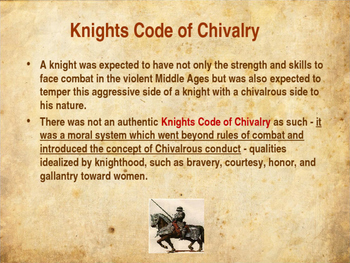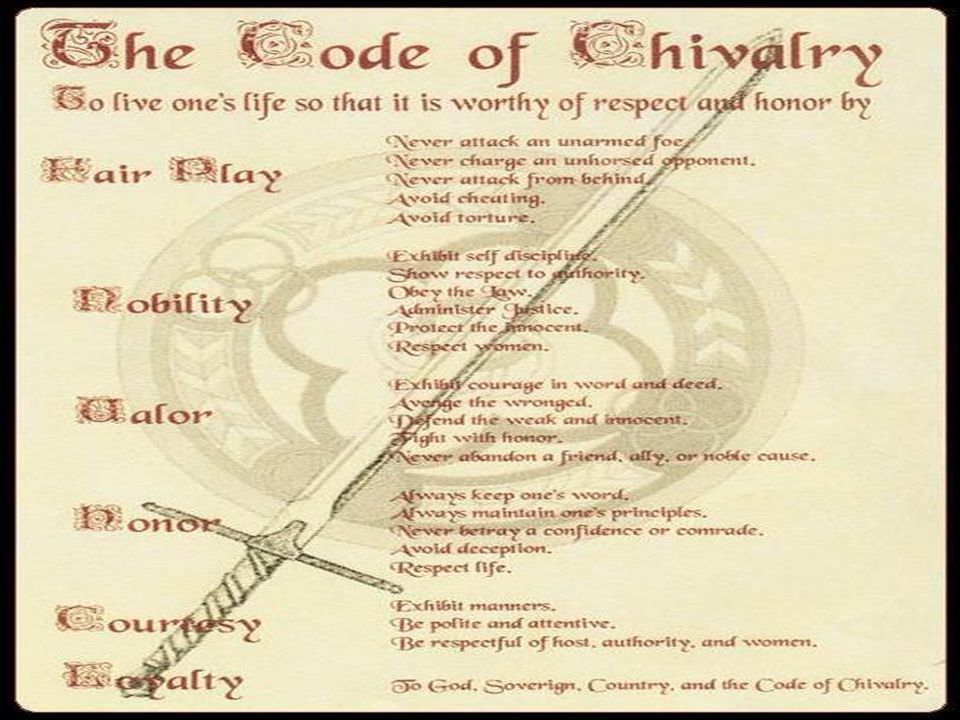



He would devote his life to winning her esteem. The chivalric hero was supposed to fall in love and find a lady to whom he would devote all of his attention, to whom he would obey in all things. Chivalric knights were supposed to engage in a form of behavior that historians call “courtly love.” Love and Romance There was one group of people to whom chivalric knights were supposed to devote more attention than any other: young, sometimes single women. Presented with the opportunity to leap to someone’s defense, the chivalric knight seized the opportunity gladly. Knights were supposed to use their prowess, loyalty, and generosity to defend clerics, peasants, widows, virgins, orphans, or people who were any combination of the above. The former were expected to use these qualities to protect those who could not protect themselves. Chivalric knights were expected to be courteous, to speak well, and exhibit good manners, doing things that heroes of the Early Middle Ages, such as Beowulf, did not. The chivalric ideal, the behavior of knights, and how they were to employ these qualities, was somewhat more distinctive. Learn more about knights the armored warriors who came to form a hereditary aristocracy with unique legal privileges Such heroes would cut a torso in half or cleave a person down the middle. They didn’t simply lop off one limb with a single blow from a sword. Fighting well was not sufficient chivalric heroes fought spectacularly well. Knights were expected to be brave, honest, loyal, and generous, and to display prowess. Qualities chivalric knights were supposed to possess are stock qualities one finds in heroic literature of every period. There were almost as many different chivalries as there were chivalric romances.Įven so, common elements recur again and again in chivalric romances, both in terms of the qualities the knight should possess, and what the knight was supposed to do with these good qualities.Ĭhivalric knights fought spectacularly well. This makes the attempt to define one chivalry perilous. The variety among different authors could be even greater. Certain authors, including Chrétien de Troyes and Marie de France, were able to craft many different kinds of chivalric heroes, each of which had his own peculiar characteristics. There’s a great deal of variety within the different chivalric romances. A disclaimer is necessary before attempting to define chivalry: although chivalric literature is filled with ogres, dragons, and highly improbable events, it is complex, despite seeming fairytale-ish. Learn more about how small innovations and events could and did have huge effects during the High Middle Ages Defining ChivalryĬhivalry, as it emerged during the 12th century, was a potent weapon in the fight against unrestrained noble violence because the codes offered knights the opportunity to play a positive role within society. Knights were taught that their ability to fight could be put to good use on behalf of and within medieval society. Instead of simply telling knights what they could not do, they began to suggest there were things knights could do to make them better individuals. Throughout the High Middle Ages, certain members of the clergy moved away from this condemnatory stance. The Peace and Truce of God movement did not appeal to medieval knights because it condemned and restricted actions they were not permitted to do.
#MEDIEVAL CHIVALRY CODE SERIES#
This is a transcript from the video series The High Middle Ages. By combining elements that appealed to nobles with elements that protected the people from nobles, medieval thinkers created the chivalric ideal. Attempting to curb the violence and warfare that was plaguing Europe, authors created the chivalric ideal often associated with the High Middle Ages, blending older, heroic ideals with new, ecclesiastical interests.
#MEDIEVAL CHIVALRY CODE CODE#
In the High Middle Ages, chivalric knights who were able to restrain their violent impulses and channel their violence into a good cause did so because certain 12th-century authors elaborated a code of conduct or ethics that medieval nobles were expected to follow. (Image: Tereshchenko Dmitry/Shutterstock) A New Heroic Ideal Where did the chivalric ideal come from? Take a close look at origins and nature of the chivalric code. By Philip Daileader, Ph.D., The College of William and Mary The High Middle Ages were home to a class of warrior aristocrats perched atop high medieval society, but these nobles were a far cry from the chivalric knights that one often associates with the era.


 0 kommentar(er)
0 kommentar(er)
